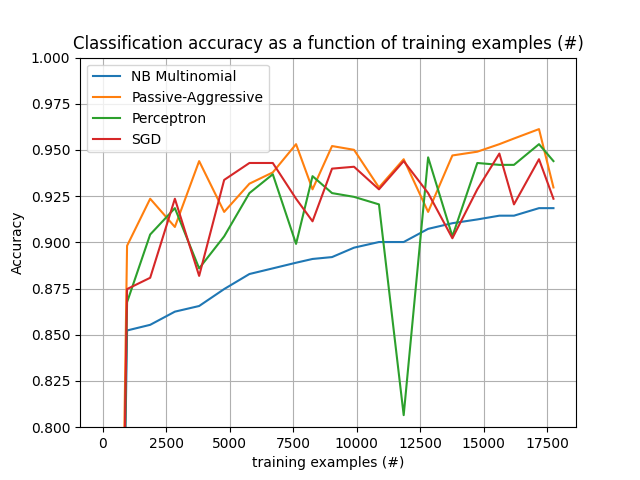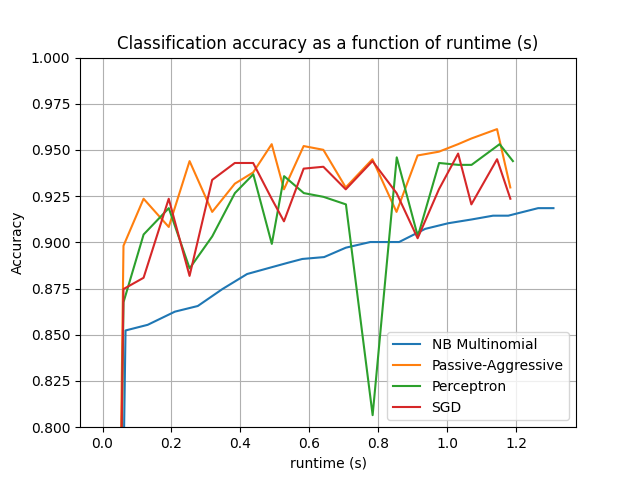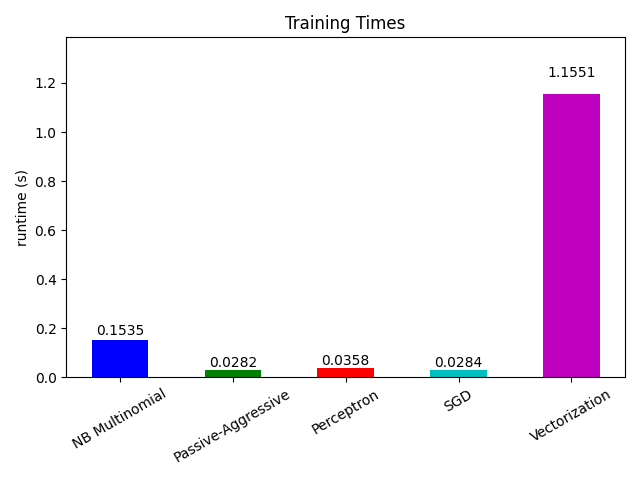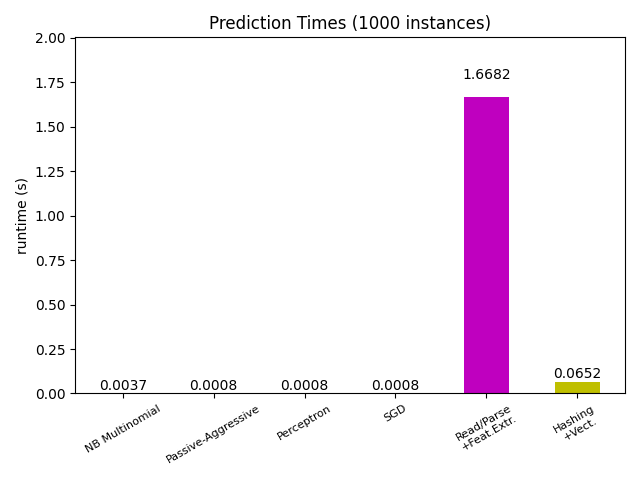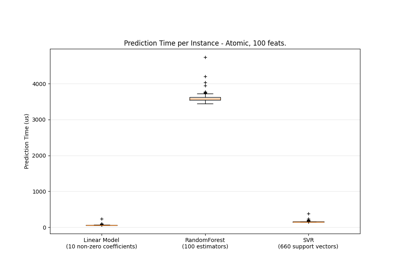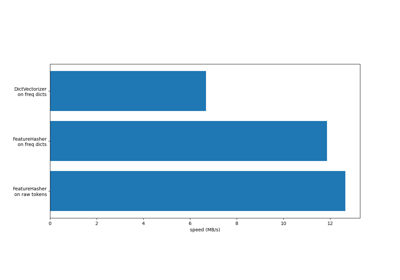Note
Go to the end to download the full example code. or to run this example in your browser via Binder
Out-of-core classification of text documents#
This is an example showing how scikit-learn can be used for classification using an out-of-core approach: learning from data that doesn’t fit into main memory. We make use of an online classifier, i.e., one that supports the partial_fit method, that will be fed with batches of examples. To guarantee that the features space remains the same over time we leverage a HashingVectorizer that will project each example into the same feature space. This is especially useful in the case of text classification where new features (words) may appear in each batch.
# Authors: The scikit-learn developers
# SPDX-License-Identifier: BSD-3-Clause
import itertools
import re
import sys
import tarfile
import time
from hashlib import sha256
from html.parser import HTMLParser
from pathlib import Path
from urllib.request import urlretrieve
import matplotlib.pyplot as plt
import numpy as np
from matplotlib import rcParams
from sklearn.datasets import get_data_home
from sklearn.feature_extraction.text import HashingVectorizer
from sklearn.linear_model import PassiveAggressiveClassifier, Perceptron, SGDClassifier
from sklearn.naive_bayes import MultinomialNB
def _not_in_sphinx():
# Hack to detect whether we are running by the sphinx builder
return "__file__" in globals()
Main#
Create the vectorizer and limit the number of features to a reasonable maximum
vectorizer = HashingVectorizer(
decode_error="ignore", n_features=2**18, alternate_sign=False
)
# Iterator over parsed Reuters SGML files.
data_stream = stream_reuters_documents()
# We learn a binary classification between the "acq" class and all the others.
# "acq" was chosen as it is more or less evenly distributed in the Reuters
# files. For other datasets, one should take care of creating a test set with
# a realistic portion of positive instances.
all_classes = np.array([0, 1])
positive_class = "acq"
# Here are some classifiers that support the `partial_fit` method
partial_fit_classifiers = {
"SGD": SGDClassifier(max_iter=5),
"Perceptron": Perceptron(),
"NB Multinomial": MultinomialNB(alpha=0.01),
"Passive-Aggressive": PassiveAggressiveClassifier(),
}
def get_minibatch(doc_iter, size, pos_class=positive_class):
"""Extract a minibatch of examples, return a tuple X_text, y.
Note: size is before excluding invalid docs with no topics assigned.
"""
data = [
("{title}\n\n{body}".format(**doc), pos_class in doc["topics"])
for doc in itertools.islice(doc_iter, size)
if doc["topics"]
]
if not len(data):
return np.asarray([], dtype=int), np.asarray([], dtype=int)
X_text, y = zip(*data)
return X_text, np.asarray(y, dtype=int)
def iter_minibatches(doc_iter, minibatch_size):
"""Generator of minibatches."""
X_text, y = get_minibatch(doc_iter, minibatch_size)
while len(X_text):
yield X_text, y
X_text, y = get_minibatch(doc_iter, minibatch_size)
# test data statistics
test_stats = {"n_test": 0, "n_test_pos": 0}
# First we hold out a number of examples to estimate accuracy
n_test_documents = 1000
tick = time.time()
X_test_text, y_test = get_minibatch(data_stream, 1000)
parsing_time = time.time() - tick
tick = time.time()
X_test = vectorizer.transform(X_test_text)
vectorizing_time = time.time() - tick
test_stats["n_test"] += len(y_test)
test_stats["n_test_pos"] += sum(y_test)
print("Test set is %d documents (%d positive)" % (len(y_test), sum(y_test)))
def progress(cls_name, stats):
"""Report progress information, return a string."""
duration = time.time() - stats["t0"]
s = "%20s classifier : \t" % cls_name
s += "%(n_train)6d train docs (%(n_train_pos)6d positive) " % stats
s += "%(n_test)6d test docs (%(n_test_pos)6d positive) " % test_stats
s += "accuracy: %(accuracy).3f " % stats
s += "in %.2fs (%5d docs/s)" % (duration, stats["n_train"] / duration)
return s
cls_stats = {}
for cls_name in partial_fit_classifiers:
stats = {
"n_train": 0,
"n_train_pos": 0,
"accuracy": 0.0,
"accuracy_history": [(0, 0)],
"t0": time.time(),
"runtime_history": [(0, 0)],
"total_fit_time": 0.0,
}
cls_stats[cls_name] = stats
get_minibatch(data_stream, n_test_documents)
# Discard test set
# We will feed the classifier with mini-batches of 1000 documents; this means
# we have at most 1000 docs in memory at any time. The smaller the document
# batch, the bigger the relative overhead of the partial fit methods.
minibatch_size = 1000
# Create the data_stream that parses Reuters SGML files and iterates on
# documents as a stream.
minibatch_iterators = iter_minibatches(data_stream, minibatch_size)
total_vect_time = 0.0
# Main loop : iterate on mini-batches of examples
for i, (X_train_text, y_train) in enumerate(minibatch_iterators):
tick = time.time()
X_train = vectorizer.transform(X_train_text)
total_vect_time += time.time() - tick
for cls_name, cls in partial_fit_classifiers.items():
tick = time.time()
# update estimator with examples in the current mini-batch
cls.partial_fit(X_train, y_train, classes=all_classes)
# accumulate test accuracy stats
cls_stats[cls_name]["total_fit_time"] += time.time() - tick
cls_stats[cls_name]["n_train"] += X_train.shape[0]
cls_stats[cls_name]["n_train_pos"] += sum(y_train)
tick = time.time()
cls_stats[cls_name]["accuracy"] = cls.score(X_test, y_test)
cls_stats[cls_name]["prediction_time"] = time.time() - tick
acc_history = (cls_stats[cls_name]["accuracy"], cls_stats[cls_name]["n_train"])
cls_stats[cls_name]["accuracy_history"].append(acc_history)
run_history = (
cls_stats[cls_name]["accuracy"],
total_vect_time + cls_stats[cls_name]["total_fit_time"],
)
cls_stats[cls_name]["runtime_history"].append(run_history)
if i % 3 == 0:
print(progress(cls_name, cls_stats[cls_name]))
if i % 3 == 0:
print("\n")
downloading dataset (once and for all) into /home/runner/scikit_learn_data/reuters
untarring Reuters dataset...
done.
Test set is 469 documents (49 positive)
SGD classifier : 467 train docs ( 42 positive) 469 test docs ( 49 positive) accuracy: 0.904 in 0.55s ( 846 docs/s)
Perceptron classifier : 467 train docs ( 42 positive) 469 test docs ( 49 positive) accuracy: 0.891 in 0.55s ( 842 docs/s)
NB Multinomial classifier : 467 train docs ( 42 positive) 469 test docs ( 49 positive) accuracy: 0.896 in 0.56s ( 827 docs/s)
Passive-Aggressive classifier : 467 train docs ( 42 positive) 469 test docs ( 49 positive) accuracy: 0.908 in 0.57s ( 823 docs/s)
SGD classifier : 3389 train docs ( 410 positive) 469 test docs ( 49 positive) accuracy: 0.947 in 1.71s ( 1981 docs/s)
Perceptron classifier : 3389 train docs ( 410 positive) 469 test docs ( 49 positive) accuracy: 0.919 in 1.71s ( 1978 docs/s)
NB Multinomial classifier : 3389 train docs ( 410 positive) 469 test docs ( 49 positive) accuracy: 0.904 in 1.72s ( 1965 docs/s)
Passive-Aggressive classifier : 3389 train docs ( 410 positive) 469 test docs ( 49 positive) accuracy: 0.964 in 1.73s ( 1963 docs/s)
SGD classifier : 6279 train docs ( 761 positive) 469 test docs ( 49 positive) accuracy: 0.949 in 2.88s ( 2179 docs/s)
Perceptron classifier : 6279 train docs ( 761 positive) 469 test docs ( 49 positive) accuracy: 0.949 in 2.88s ( 2177 docs/s)
NB Multinomial classifier : 6279 train docs ( 761 positive) 469 test docs ( 49 positive) accuracy: 0.910 in 2.89s ( 2169 docs/s)
Passive-Aggressive classifier : 6279 train docs ( 761 positive) 469 test docs ( 49 positive) accuracy: 0.962 in 2.90s ( 2168 docs/s)
SGD classifier : 9135 train docs ( 1164 positive) 469 test docs ( 49 positive) accuracy: 0.962 in 4.03s ( 2264 docs/s)
Perceptron classifier : 9135 train docs ( 1164 positive) 469 test docs ( 49 positive) accuracy: 0.955 in 4.04s ( 2263 docs/s)
NB Multinomial classifier : 9135 train docs ( 1164 positive) 469 test docs ( 49 positive) accuracy: 0.928 in 4.05s ( 2257 docs/s)
Passive-Aggressive classifier : 9135 train docs ( 1164 positive) 469 test docs ( 49 positive) accuracy: 0.962 in 4.05s ( 2256 docs/s)
SGD classifier : 11949 train docs ( 1516 positive) 469 test docs ( 49 positive) accuracy: 0.955 in 5.19s ( 2300 docs/s)
Perceptron classifier : 11949 train docs ( 1516 positive) 469 test docs ( 49 positive) accuracy: 0.962 in 5.20s ( 2299 docs/s)
NB Multinomial classifier : 11949 train docs ( 1516 positive) 469 test docs ( 49 positive) accuracy: 0.932 in 5.21s ( 2295 docs/s)
Passive-Aggressive classifier : 11949 train docs ( 1516 positive) 469 test docs ( 49 positive) accuracy: 0.957 in 5.21s ( 2294 docs/s)
SGD classifier : 14793 train docs ( 1885 positive) 469 test docs ( 49 positive) accuracy: 0.964 in 6.34s ( 2332 docs/s)
Perceptron classifier : 14793 train docs ( 1885 positive) 469 test docs ( 49 positive) accuracy: 0.968 in 6.34s ( 2331 docs/s)
NB Multinomial classifier : 14793 train docs ( 1885 positive) 469 test docs ( 49 positive) accuracy: 0.945 in 6.36s ( 2327 docs/s)
Passive-Aggressive classifier : 14793 train docs ( 1885 positive) 469 test docs ( 49 positive) accuracy: 0.962 in 6.36s ( 2326 docs/s)
SGD classifier : 17722 train docs ( 2235 positive) 469 test docs ( 49 positive) accuracy: 0.968 in 7.49s ( 2366 docs/s)
Perceptron classifier : 17722 train docs ( 2235 positive) 469 test docs ( 49 positive) accuracy: 0.938 in 7.49s ( 2365 docs/s)
NB Multinomial classifier : 17722 train docs ( 2235 positive) 469 test docs ( 49 positive) accuracy: 0.947 in 7.50s ( 2362 docs/s)
Passive-Aggressive classifier : 17722 train docs ( 2235 positive) 469 test docs ( 49 positive) accuracy: 0.962 in 7.50s ( 2361 docs/s)
Plot results#
The plot represents the learning curve of the classifier: the evolution of classification accuracy over the course of the mini-batches. Accuracy is measured on the first 1000 samples, held out as a validation set.
To limit the memory consumption, we queue examples up to a fixed amount before feeding them to the learner.
def plot_accuracy(x, y, x_legend):
"""Plot accuracy as a function of x."""
x = np.array(x)
y = np.array(y)
plt.title("Classification accuracy as a function of %s" % x_legend)
plt.xlabel("%s" % x_legend)
plt.ylabel("Accuracy")
plt.grid(True)
plt.plot(x, y)
rcParams["legend.fontsize"] = 10
cls_names = list(sorted(cls_stats.keys()))
# Plot accuracy evolution
plt.figure()
for _, stats in sorted(cls_stats.items()):
# Plot accuracy evolution with #examples
accuracy, n_examples = zip(*stats["accuracy_history"])
plot_accuracy(n_examples, accuracy, "training examples (#)")
ax = plt.gca()
ax.set_ylim((0.8, 1))
plt.legend(cls_names, loc="best")
plt.figure()
for _, stats in sorted(cls_stats.items()):
# Plot accuracy evolution with runtime
accuracy, runtime = zip(*stats["runtime_history"])
plot_accuracy(runtime, accuracy, "runtime (s)")
ax = plt.gca()
ax.set_ylim((0.8, 1))
plt.legend(cls_names, loc="best")
# Plot fitting times
plt.figure()
fig = plt.gcf()
cls_runtime = [stats["total_fit_time"] for cls_name, stats in sorted(cls_stats.items())]
cls_runtime.append(total_vect_time)
cls_names.append("Vectorization")
bar_colors = ["b", "g", "r", "c", "m", "y"]
ax = plt.subplot(111)
rectangles = plt.bar(range(len(cls_names)), cls_runtime, width=0.5, color=bar_colors)
ax.set_xticks(np.linspace(0, len(cls_names) - 1, len(cls_names)))
ax.set_xticklabels(cls_names, fontsize=10)
ymax = max(cls_runtime) * 1.2
ax.set_ylim((0, ymax))
ax.set_ylabel("runtime (s)")
ax.set_title("Training Times")
def autolabel(rectangles):
"""attach some text vi autolabel on rectangles."""
for rect in rectangles:
height = rect.get_height()
ax.text(
rect.get_x() + rect.get_width() / 2.0,
1.05 * height,
"%.4f" % height,
ha="center",
va="bottom",
)
plt.setp(plt.xticks()[1], rotation=30)
autolabel(rectangles)
plt.tight_layout()
plt.show()
# Plot prediction times
plt.figure()
cls_runtime = []
cls_names = list(sorted(cls_stats.keys()))
for cls_name, stats in sorted(cls_stats.items()):
cls_runtime.append(stats["prediction_time"])
cls_runtime.append(parsing_time)
cls_names.append("Read/Parse\n+Feat.Extr.")
cls_runtime.append(vectorizing_time)
cls_names.append("Hashing\n+Vect.")
ax = plt.subplot(111)
rectangles = plt.bar(range(len(cls_names)), cls_runtime, width=0.5, color=bar_colors)
ax.set_xticks(np.linspace(0, len(cls_names) - 1, len(cls_names)))
ax.set_xticklabels(cls_names, fontsize=8)
plt.setp(plt.xticks()[1], rotation=30)
ymax = max(cls_runtime) * 1.2
ax.set_ylim((0, ymax))
ax.set_ylabel("runtime (s)")
ax.set_title("Prediction Times (%d instances)" % n_test_documents)
autolabel(rectangles)
plt.tight_layout()
plt.show()
Total running time of the script: (0 minutes 10.056 seconds)
Related examples
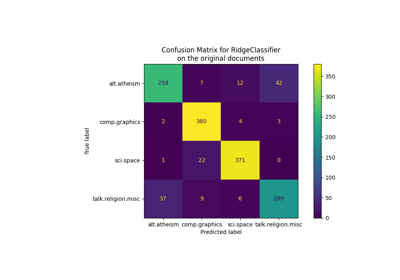
Classification of text documents using sparse features

Column Transformer with Heterogeneous Data Sources

